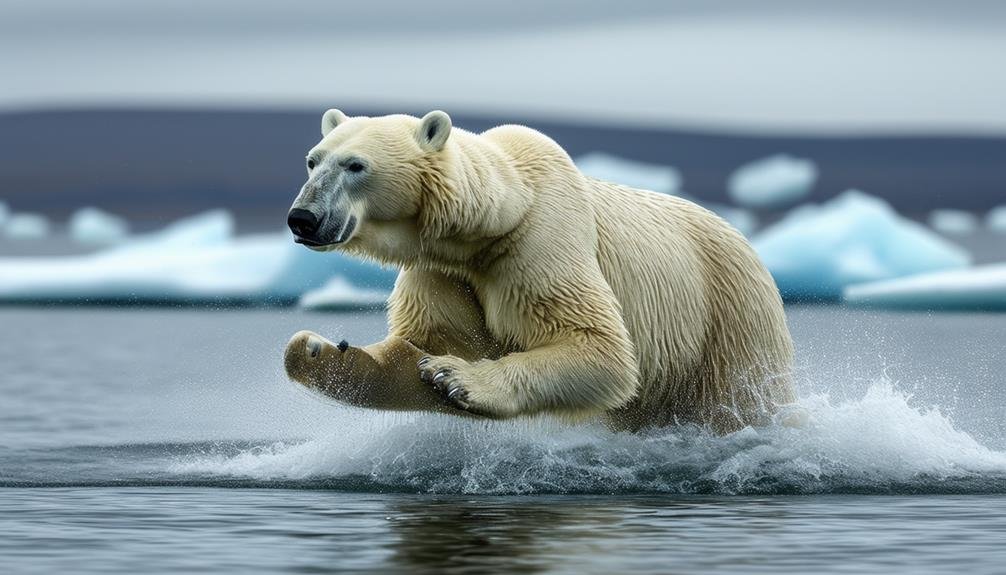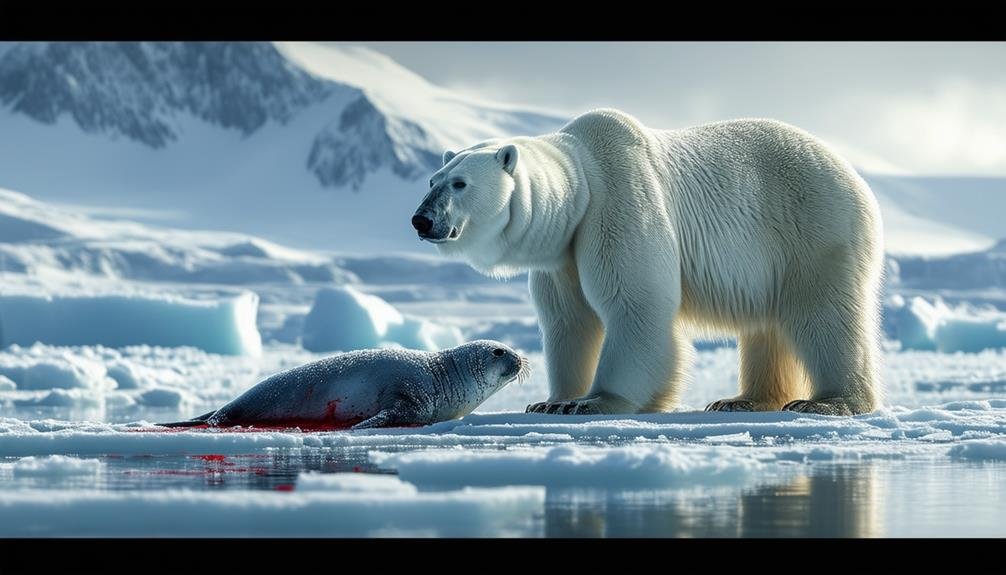Polar bears mainly feed on seals, especially ringed seals, which supply the vital fat needed for energy and survival. Their specialized hunting techniques, such as ambushing at breathing holes, showcase remarkable adaptability. Additionally, they hunt other seal species and occasionally resort to alternative food sources like berries, grass, and algae during times of scarcity. Seasonal variations in prey availability force polar bears to adjust their diet, often relying on terrestrial foods as sea ice breaks up. Understanding these dietary habits is crucial for grasping how polar bears thrive in their harsh Arctic environment. Discover more about their diet and survival strategies.
Main Points
- Polar bears primarily feed on seals, especially ringed seals, for essential fat reserves.
- During scarcity, polar bears adapt by consuming berries, grass, marine algae, reindeer, and birds.
- Efficient hunters, polar bears ambush seals at breathing holes or pursue them in water.
- Seasonal diet shifts occur, with land-based foods becoming crucial as sea ice breaks up.
- High-fat intake, around 2 kg daily, is vital for polar bears' energy and metabolic needs.
Primary Prey: Seals
Polar bears mainly feed on seals, with ringed seals constituting their main source of high-energy nutrition. The polar bears' diet is heavily reliant on these marine mammals, as seals provide over 95% of their food intake. This dependency is essential for maintaining the bears' fat reserves, which are necessary for survival in the harsh Arctic environment. Polar bears have evolved specialized hunting techniques to catch seals, including ambushing them at breathing holes or breaking into seal birth lairs where pups are housed.
In addition to ringed seals, polar bears also hunt other seal species such as bearded seals, harp seals, and hooded seals. These marine mammals are rich in fat, which is crucial for polar bears to build and maintain their energy stores. The bears utilize the sea ice as a platform to hunt seals, taking advantage of their excellent swimming and diving abilities.
While ringed seals are the primary prey, polar bears' dietary habits can extend to other marine mammals, reinforcing their status as apex predators in the Arctic ecosystem. The availability of seals is essential to the polar bears' diet, although they may turn to alternate prey when seal populations are low.
Opportunistic Feeding
In times of scarcity, polar bears exhibit opportunistic feeding behaviors, diversifying their diet to include a range of alternative food sources. When their primary prey, seals, are unavailable, polar bears demonstrate remarkable adaptability to changing environmental conditions by consuming various land-based and marine resources. These alternative food sources may include berries, grass, and marine algae, which provide essential nutrients during lean periods.
Moreover, polar bears have been observed hunting reindeer and birds, as well as scavenging on carcasses, highlighting their capacity to exploit different food opportunities. This behavioral flexibility is pivotal for their survival, especially in regions where seals are particularly scarce. Opportunistic feeding allows polar bears to maintain their energy levels and sustenance, even when their preferred prey is not accessible.
Understanding the opportunistic feeding habits of polar bears is vital for conservation efforts. As the Arctic ecosystem undergoes rapid changes due to climate fluctuations, these adaptive behaviors play a significant role in the species' resilience and long-term survival. By recognizing the importance of alternative food sources, conservationists can better manage and support polar bear populations in a dynamically shifting environment.
Hunting Techniques

While opportunistic feeding highlights their adaptability, the primary survival strategy of polar bears relies on sophisticated hunting techniques to capture seals. One of the most effective methods employed by these apex predators is ambush hunting. Polar bears patiently wait by sealing breathing holes or near ice edges, where seals frequently surface to breathe. Utilizing their exceptional sense of smell, they can detect seals even when they are hidden beneath thick ice.
Polar bears also engage in stalking seals, a technique that involves silently approaching their prey on the ice before launching a swift attack. Additionally, they are proficient swimmers and divers, which allows them to pursue seals in the water, further showcasing their versatile hunting techniques.
Scavenging is another vital part of their feeding habits. When hunting opportunities are scarce, polar bears often rely on scavenging carcasses to sustain themselves, demonstrating their opportunistic nature.
Their ability to adapt their hunting strategies based on prey availability and environmental conditions highlights their remarkable survival skills. By mastering a combination of ambush hunting, stalking, and scavenging, polar bears effectively secure the nutrition necessary to thrive in the harsh Arctic environment.
Seasonal Diet Variations
Throughout the year, polar bears exhibit significant dietary variations in response to seasonal changes in prey availability and environmental conditions. In spring, the polar bear diet primarily consists of ringed seals, which are abundant and provide essential fat reserves. This period is pivotal for building up energy stores to sustain the bears through the leaner summer months.
As summer approaches and the ice begins to break up, polar bears face reduced access to their primary prey. Consequently, they adapt by shifting to terrestrial foods such as caribou, snow geese, and eggs. The advancing ice breakup in regions like Hudson Bay forces bears to seek alternative prey on land. These diet shifts highlight the polar bear's remarkable adaptability in the face of changing environmental conditions.
Monitoring these dietary variations is crucial for conservation efforts, especially in the context of climate change, which impacts seal availability. Increased reliance on land-based prey indicates potential stress on the polar bear population as they adjust to a rapidly changing habitat. Understanding these seasonal diet variations aids in developing strategies to mitigate the effects of environmental changes and ensure the long-term survival of this iconic species.
Nutritional Needs

Understanding the nutritional needs of polar bears is essential for maintaining their health and energy levels. Polar bears require a significant amount of fat, approximately 2 kg per day, to sustain their high energy demands, primarily sourced from prey like ringed seals. Additionally, their ability to efficiently assimilate up to 97% of consumed fat highlights the importance of high-energy food sources, especially given their variable dietary intake across different seasons.
Essential Daily Fat Intake
To sustain their high energy levels, polar bears require an average daily fat intake of approximately 2 kg (4.4 lb.). This high fat consumption is essential for meeting the immense energy demands associated with their active lifestyle. Polar bears primarily obtain this necessary fat from prey such as the ringed seal. A single ringed seal weighing around 55 kg (121 lb.) can provide adequate energy for a polar bear for up to eight days.
Polar bears demonstrate remarkable efficiency in assimilating nutrients, with an ability to process 84% of the protein and 97% of the fat they consume. This high rate of fat assimilation ensures that they can maximize the energy derived from their prey, which is particularly important during periods of increased activity, such as hunting and the breeding season.
During hibernation, polar bears do not consume food as their metabolic rate significantly decreases, enabling them to conserve energy. Outside of hibernation, the need for fat intake rises, especially when energy demands peak. The high-fat diet is essential for maintaining their metabolic functions and supporting their energy-intensive activities throughout the year. In short, fat intake is a fundamental aspect of polar bears' nutritional needs.
High-Energy Food Sources
Polar bears rely on high-energy food sources like seals to meet their significant nutritional needs. The polar bear's natural diet is mainly made up of marine mammals, with ringed seals being a primary source. These seals provide necessary fat reserves that are essential for the bears' survival in the harsh Arctic environment. The high fat content in ringed seals allows polar bears to build up significant reserves, which are crucial for maintaining energy levels during periods of scarcity.
Other marine mammals, such as beluga whales and bearded seals, also contribute to the high-energy diet needed by polar bears. These animals offer rich sources of fat and protein, which are essential for meeting the bears' nutritional requirements. The following list outlines key components of a polar bear's high-energy diet:
- Ringed Seals: Primary food source, providing the essential fat required for energy storage.
- Beluga Whales: Additional high-fat content, enhancing dietary variety and nutritional balance.
- Bearded Seals: Extra source of fat and protein, supporting overall health and energy needs.
Seasonal Dietary Adjustments
As the availability of high-energy food sources like seals fluctuates throughout the year, polar bears must adjust their diet seasonally to guarantee they meet their nutritional needs. During the peak hunting season, polar bears primarily consume seals, which are rich in fat and essential for building the necessary fat reserves to sustain them through periods of food scarcity. This high-fat diet is crucial for maintaining their energy levels and overall health.
However, when seals become less accessible, polar bears exhibit remarkable adaptability in their diet. They may turn to alternative food sources such as berries, kelp, and even human garbage to supplement their nutritional intake. These seasonal adjustments in their diet are important for their survival, especially in the face of climate change, which is increasingly affecting the availability of their primary prey.
Understanding these dietary shifts is vital, as polar bears' nutritional needs vary throughout the year, influencing their hunting behaviors and foraging strategies. The ability to adapt to seasonal changes in food availability underscores their resilience in the harsh Arctic environment. As climate change continues to impact their habitat, these dietary adjustments will play a significant role in their ongoing survival.
Adaptations to Climate Change
Driven by the accelerating changes in their Arctic environment, polar bears in Western Hudson Bay have begun incorporating terrestrial foods into their diet as an important adaptation to climate change. As the ice breaks up earlier in the spring, polar bears face reduced access to their primary prey, seals. Consequently, they have turned to land-based food sources, including caribou, snow geese, and the eggs and young of waterfowl. This diet shift underscores their remarkable adaptability to changing environmental conditions.
To better understand these adaptations, researchers have identified several key observations:
- Increasing Land-Based Prey: Polar bears are actively pursuing alternate prey on land due to the shorter seal hunting season caused by diminishing ice.
- Dietary Monitoring: Tracking diet shifts is crucial for conservation efforts, providing insights into how polar bears are coping with reduced ice conditions.
- Adaptive Strategies: The consumption of terrestrial foods highlights polar bears' ability to modify their foraging strategies in response to climate change.
Understanding these dietary changes is important for developing effective conservation strategies. By studying polar bears' adaptations, scientists can better predict their long-term survival and implement measures to mitigate the impacts of a rapidly changing environment.
Are the Key Foods in a Wild Polar Bear’s Diet the Same as Those in Their Natural Diet?
A wild polar bear diet primarily consists of seals, which provide the essential fat and nutrients they need to survive in their icy habitat. While their natural diet is similar, a wild polar bear diet also occasionally includes birds, fish, and other arctic animals whenever food becomes scarce.
Conclusion
The study of polar bears' natural diet reveals reliance on seals as primary prey, supplemented by opportunistic feeding. Various hunting techniques and seasonal diet variations address their nutritional needs. Adaptations to climate change are critical for survival, given their specific dietary requirements. Understanding these factors is essential for conservation efforts, ensuring the preservation of polar bear populations in changing environments. Effective strategies must consider these dietary habits to support their health and ecological role.


